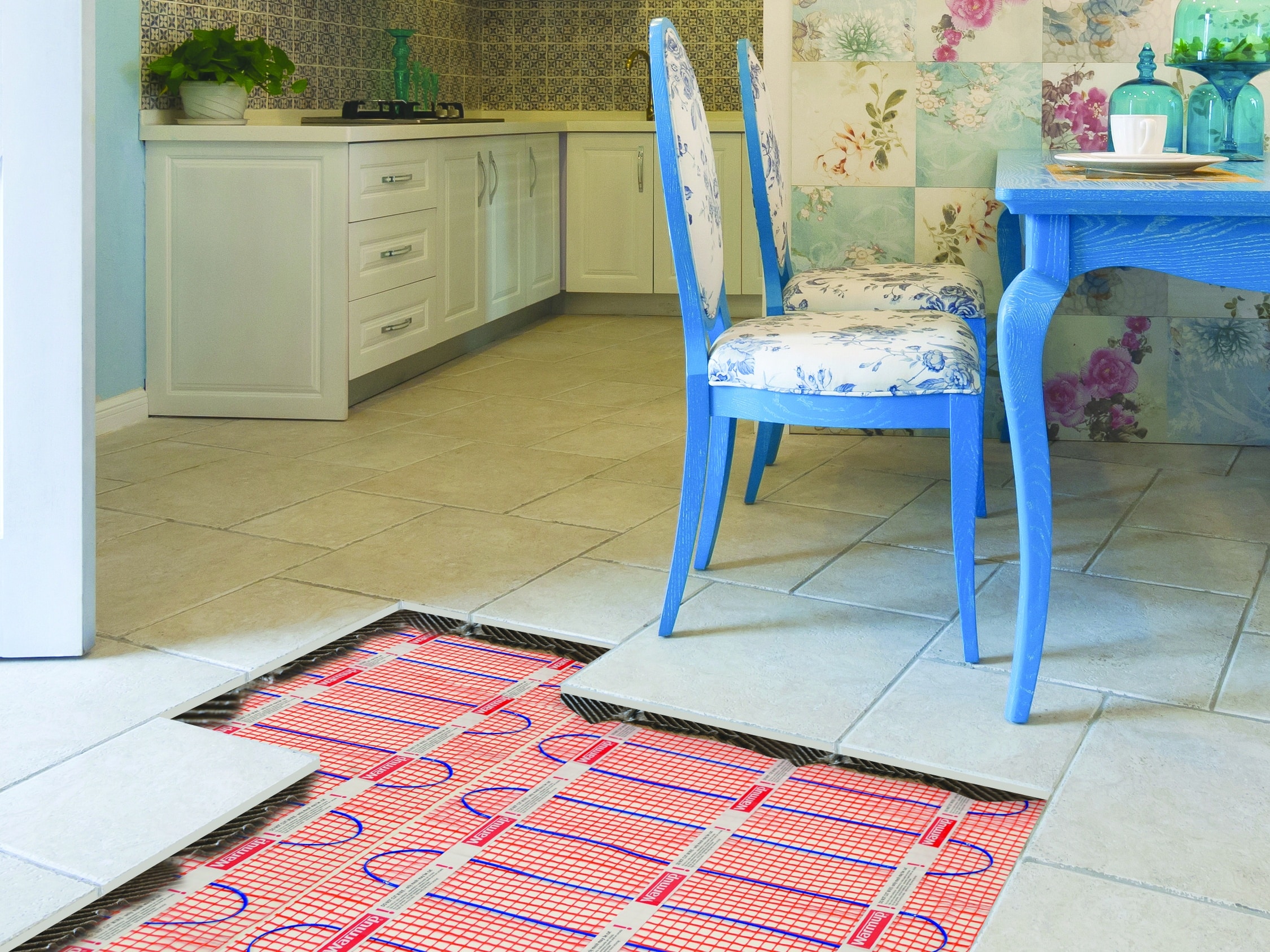Electric underfloor heating systems have become increasingly popular in both new builds as well as retrofitting onto existing subfloors. If you’ve decided that underfloor heating is the preferred solution for your project and that an electric system is the route to take, read on. This article provides you with an overview of the various types available, the differences between them, and then provides some more in-depth information on electric underfloor heating mats.

Different types of Electric Underfloor Heating
Electric underfloor heaters come in various forms and the type you choose would depend on the specifications of your project. An irregularly shaped room with many units to work around would benefit from the flexibility of a loose wire heater. The Loose Wire underfloor heating system is the most versatile to fit around objects or in irregular-shaped areas. The cable can simply be maneuvered around furniture in the room, whether that’s basins and toilets in bathrooms or washing machines and fridges in kitchens. Loose Wire can be applied to existing concrete or screeded subfloors, as well as directly onto robust insulation boards.
Electric UFH mats are, on the other hand, quicker and easier to install in larger, more regular rooms than the Loose Wire version. Cover a big area with a pre-spaced mat that you can simply roll out over the floor, or, in the case of a decoupling mat, attach to the floor.
Matting systems come in 150W to 230W versions. Ultra-thin electric underfloor heating mat systems such as a StickyMat system are suited ideally to be fitted on top of an existing concrete subfloor since it does not alter the floor levels visibly.
Fully earthed systems such as the Warmup Foil Heater make for shorter installations in wet areas as the integrated safety mechanism eliminates the need for additional grounding nets.
If electric UFH mats sound like the more suitable system for your project by now, then keep on reading. If you are not sure what electric system meets your requirements, send us a quote and we will specify the most suited system for you for free.
This article discusses the features of electric floor heater mats, their installation processes, and suitability with different floor types.
Electric Underfloor Heating Mats
As mentioned before, floor heating mats are especially suitable for regular shaped rooms and for heating a large area evenly. When you measure and create the floor plan, remember to subtract any fixtures such as baths and cupboards to ensure you get the correct size mat for the floor area.
The electric systems with higher wattage are designed for rooms where the heat loss may be higher, such as conservatories. If insulation is required, insulation boards should be laid down first using flexible tile adhesive. Depending on the system, the mat heater is applied next using either the incorporated self-adhesive tape or if the heater is a decoupling mat, with a self-adhesive backing straight onto the insulation boards. The system can then be screeded over before tiling, or even directly tiled over. Both systems can be used as the primary heat source and are best suited to permanent floor finishes including natural stone or ceramic.
Make sure you carry out a heat loss calculation prior to any project if you use the system as a primary source of heat to guarantee efficient performance.

Different Sizes
The StickyMat relieves the installer from inserting the cable into the mat. The pre-spaced, pre-adhered cable allows the installer to focus entirely on laying the mat correctly, quickly and efficiently. Even if mistakes are made when laying the mat, the adhesive qualities of the mat allow it to be repositioned and stuck down once more without losing adhesion.
Furthermore, the mesh of the StickyMat can be cut where necessary to fit perfectly on the floor space in use, as long as the heating cable is not cut. You can read more about cutting an electric system later in the article.
The other electric underfloor heating mat from Warmup, DCM-PRO heated decoupling mat, has been designed so that the one-meter cable box fits 1 square meter of mat perfectly. Therefore, no measuring or calculating is required to find out the correct length of the cable. You can still decide which heat output you want the heater to provide by adjusting the spacing of the cable on the mat to either increase or decrease the power output per square meter. In other words, the higher the density of cable channels, the higher the heat output, 230 Watts per square meter being the maximum. The further away you space the cable on the mat the less heat output it provides. The recommended cable spacing is three castellations, or 90mm, which provides 150 Watts per square meter, also known as the optimal power output ratio.
Can UFH Mats Be Cut to Fit an Area?
It is important that the correct size heater is installed based on the available space as the heating cable cannot be cut. This rule applies irrespective of whether you are using a mesh or a decoupling mat. Should you need to extend the cables, the floor probe and power supply cables can be extended to up to 50 meters by a qualified electrician. A certified electrician should be consulted for advice on extending the cable.
Installation
Every heating system has specific installation instructions and it is crucial to follow the manufacturer’s installation manual step-by-step to perform this correctly. If you have any doubts during any stage of the installation, always contact the manufacturer for help.
The Warmup StickyMat system comes in 200W and consists of a thin Warmup Loose Wire spaced and taped to a sturdy mesh. This makes the installation quick as the mat can simply be rolled out a length, cut (never cut the cable, just the matting), flipped, and stuck down until the flooring area is entirely covered.
The heating mat has a 1.8mm pre-spaced wire with a multi-strand core and double insulation with advanced fluoropolymer. The sturdy fiberglass mesh is extra durable and has super sticky double sided tape for secure installation. Thus the mat simply needs to be rolled out to begin the installation.
StickyMat heating cable is so thin that it does not raise the floor height visually. Therefore StickyMat makes an ideal system for retrofitting where the floor heights cannot be altered much. StickyMat is the most popular system for existing floors and rectangularly shaped smaller areas.
Watch a step-by-step installation guide to the StickyMat System:
The DCM-PRO heated decoupling system from Warmup caters for those looking for the fastest way to install and experience underfloor heating with all types of floor finishes. It is also built for slightly different project specifications than the StickyMat. DCM-PRO consists of a 5.5 mm thick mat and a cable possessing new innovative features to an electric underfloor heating system providing homeowners with a durable, protective floor heating solution that will last for years. The DCM-PRO heater raises the floor level more than the StickyMat and is therefore the best possible electric underfloor heating mat to be used in new builds where the floor height has not been set yet. The decoupling mat is suitable for all areas from living room and kitchen, to basement and bathroom and can be installed in minutes with less tile adhesive.
As discussed previously in the article, the DCM-PRO mat has pre-spaced channels to guide the insertion of the cable, so it is easy to space the heating cable evenly in the castellations of the mat. It is also notable that inserting the cable does not require any additional tools; the cable is effortlessly applied by pressing it in the castellation with your thumb. Furthermore, the channels on the mat are designed to perfectly accommodate all cable sizes.
The cable itself is durable, reliable and flexible, making it easy to handle and insert into the mat. With full confidence in the high-durability of the cable, Warmup offers a lifetime warranty when installed with the DCM-PRO Mat.
In addition to these features of the cable, the DCM-PRO decoupling mat has an adhesive backing layer so it is effortless to lay it down. The mat is attached directly to the subfloor without the need to mix tile adhesive and wait for it to dry. Make sure to clean the subfloor from any dust before starting the installation to ensure that the membrane glues to the floor properly.
The next step of the installation depends on your preferences. You can either apply a layer of tile adhesive on top of the system prior to tiling over it or you can pour self-levelling compound onto the system to give it a smooth surface before laying down the floor covering.
DCM-PRO can be waterproofed with a special tape to cover it and a layer of self-leveller to finalise the protection of the system. The castellations in the membrane allow for easy pouring and spreading of self-levelling compound, without the worry of any holes or air gaps. Installation of the DCM-PRO system in other rooms than a bathroom does not require waterproofing or self-leveller as an adhesive on the system is enough to apply the floor finish directly on it.
Watch a step-by-step installation guide to the DCM-PRO System:
Find more Warmup installation videos here.
UFH Mats with Different floor Types
A frequently asked question is what floor type you can use with an underfloor heating system. Even though choosing your floor covering is an integral part of your project, it alone does not rule what system you should go for. Deciding on the correct underfloor heating depends on multiple factors such as the size of your project, whether you are working on a new build or a renovation etc. Next, we discuss the compatibility of electric UFH mats with different floor coverings.
The StickyMat system can be used with tiles, stone, wood and vinyl floorings. The StickyMat’s main advantages, as mentioned above, are the ease and speed of installation, along with the 1.8mm system height that does not raise floor levels. This means that the StickyMat is the ideal situation for anyone who needs to complete the job rapidly, or has a concern for floor height alterations once the system is in place.
As much as for StickyMat, all floor types suitable for underfloor heating are also compatible with the DCM-PRO system. The DCM-PRO is an especially sought after the system for tiles due to its self-healing features that protect the tiles from cracking. However, DCM-PRO can be considered for use with all floor finishes.
There is an underfloor heating system for every situation whether you are laying a stone or ceramic floor, carpets, wood or vinyl. Warmup has also a comprehensive range of heating controls that can be used on all systems making programming simple – even on multi-zoned projects.
Find below more detailed articles about specific floor types with underfloor heating:
- Underfloor Heating and Tiles
- Underfloor Heating and Vinyl
- Underfloor Heating and Carpet
- Underfloor Heating and Wooden Floor
If you have any questions or would like further information, contact our customer service or ask for a quote.

















